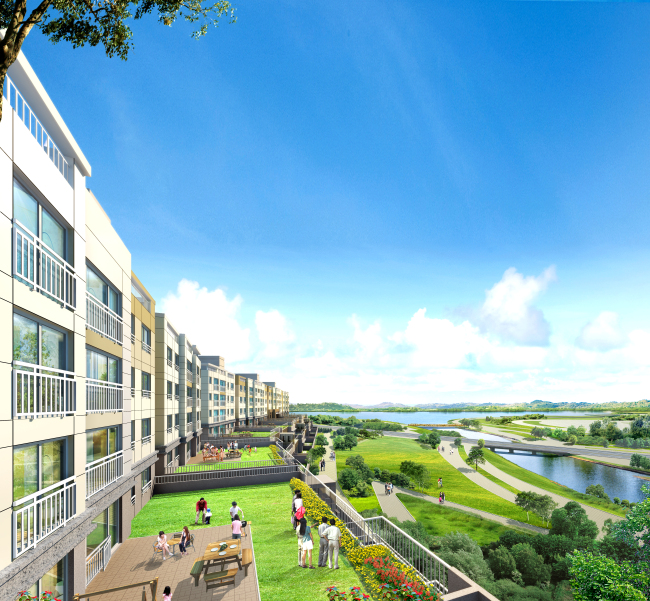
Home-owners in the new city of Sejong are among the few groups of real estate purchasers enjoying high returns on their investments this year.
“Despite the prolonged slump in the nation’s real estate market, winter has never come to the housing market in Sejong City,” Kwon Il, the research team manager of Dr. APT, a local real estate market information provider, said by phone.
According to a recent survey released on Dec. 3 by Dr. APT on price increases of newly built apartments nationwide this year, apartments in Sejong City took the top four rankings.
Homes of 161 square meters with spacious terraces in POSCO’s The Sharp Lake Park apartment complex, which opened to residents in Sejong’s Eojin-dong in July, came out on top in the survey, as the prices of these 36 eco-friendly homes soared 40 to 50 percent or from 200 million won-250 million won ($190,000-$238,000) to 700 million won-750 million won, compared with initial sales prices in 2011. These 36 homes in the complex each have a 40-square-meter terrace, which can be transformed into a small garden or organic farm.
“Other, smaller houses without a terrace in the same apartment complex also rose 100 million won as the complex, after all, is only a few minutes’ walk from the Sejong government complex and soon-to-be-opened commercial facilities, including a discount chain store and culture center,” Kwon said.
“The pace of the price hike might ease with the continued home supply,” he continued. “But the home- buying spree in Sejong City will continue as people are betting on rapid population growth in the city.”
Data from the Multifunctional Administrative City Construction Agency found that the population in Sejong City has grown at a fast speed over the past two years. The number of Sejong City residents, which was only 875 in 2011, is expected to reach 32,000 by the end of this year, when the second stage in the relocation of six ministries to the Government Complex Sejong is completed.
In contrast to Sejong City, the real estate market of Gwacheon in Gyeonggi Province, with a population of 72,000 residents, which had a reputation as an administrative city because of the Gwacheon Government Complex, has been hit hard by the rise of the new administrative city.
“The price of apartments in Gwacheon plunged 30 percent last year from their peak in 2006, and it seems unlikely that we’ll be seeing good news about a boost to the market for the time being,’’ Kwon said.
By Seo Jee-yeon (jyseo@heraldcorp.com)
“Despite the prolonged slump in the nation’s real estate market, winter has never come to the housing market in Sejong City,” Kwon Il, the research team manager of Dr. APT, a local real estate market information provider, said by phone.
According to a recent survey released on Dec. 3 by Dr. APT on price increases of newly built apartments nationwide this year, apartments in Sejong City took the top four rankings.
Homes of 161 square meters with spacious terraces in POSCO’s The Sharp Lake Park apartment complex, which opened to residents in Sejong’s Eojin-dong in July, came out on top in the survey, as the prices of these 36 eco-friendly homes soared 40 to 50 percent or from 200 million won-250 million won ($190,000-$238,000) to 700 million won-750 million won, compared with initial sales prices in 2011. These 36 homes in the complex each have a 40-square-meter terrace, which can be transformed into a small garden or organic farm.
“Other, smaller houses without a terrace in the same apartment complex also rose 100 million won as the complex, after all, is only a few minutes’ walk from the Sejong government complex and soon-to-be-opened commercial facilities, including a discount chain store and culture center,” Kwon said.
“The pace of the price hike might ease with the continued home supply,” he continued. “But the home- buying spree in Sejong City will continue as people are betting on rapid population growth in the city.”
Data from the Multifunctional Administrative City Construction Agency found that the population in Sejong City has grown at a fast speed over the past two years. The number of Sejong City residents, which was only 875 in 2011, is expected to reach 32,000 by the end of this year, when the second stage in the relocation of six ministries to the Government Complex Sejong is completed.
In contrast to Sejong City, the real estate market of Gwacheon in Gyeonggi Province, with a population of 72,000 residents, which had a reputation as an administrative city because of the Gwacheon Government Complex, has been hit hard by the rise of the new administrative city.
“The price of apartments in Gwacheon plunged 30 percent last year from their peak in 2006, and it seems unlikely that we’ll be seeing good news about a boost to the market for the time being,’’ Kwon said.
By Seo Jee-yeon (jyseo@heraldcorp.com)



![[Exclusive] Korean military set to ban iPhones over 'security' concerns](http://res.heraldm.com/phpwas/restmb_idxmake.php?idx=644&simg=/content/image/2024/04/23/20240423050599_0.jpg&u=20240423183955)
![[AtoZ into Korean mind] Humor in Korea: Navigating the line between what's funny and not](http://res.heraldm.com/phpwas/restmb_idxmake.php?idx=644&simg=/content/image/2024/04/22/20240422050642_0.jpg&u=)




![[Graphic News] 77% of young Koreans still financially dependent](http://res.heraldm.com/phpwas/restmb_idxmake.php?idx=644&simg=/content/image/2024/04/22/20240422050762_0.gif&u=)
![[Herald Interview] Why Toss invited hackers to penetrate its system](http://res.heraldm.com/phpwas/restmb_idxmake.php?idx=644&simg=/content/image/2024/04/22/20240422050569_0.jpg&u=20240422150649)




![[Exclusive] Korean military to ban iPhones over security issues](http://res.heraldm.com/phpwas/restmb_idxmake.php?idx=652&simg=/content/image/2024/04/23/20240423050599_0.jpg&u=20240423183955)



![[Today’s K-pop] Ateez confirms US tour details](http://res.heraldm.com/phpwas/restmb_idxmake.php?idx=642&simg=/content/image/2024/04/23/20240423050700_0.jpg&u=)